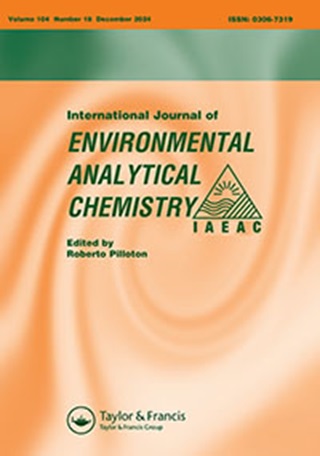Extraction of Novichoks from aqueous samples for verification analysis of Chemical Weapons Convention
IF 2.5
4区 化学
Q3 CHEMISTRY, ANALYTICAL
International Journal of Environmental Analytical Chemistry
Pub Date : 2023-10-23
DOI:10.1080/03067319.2023.2269853
引用次数: 0
Abstract
ABSTRACTThe study was undertaken with the objective of evaluating the different procedures for the extraction of the Novichok class of chemicals from aqueous samples for the verification of Chemical Weapons Convention (CWC). These classes of chemicals are recently added to the scheduled list of CWC, which necessitates the optimisation of analytical protocols for their verification analyses in different environmental samples. Three analytes, namely N-(1-(diethylamino)ethylidene)-P-methylphosphonamidic fluoride (A230), methyl N-(1-(diethylamino)ethylidene)phosphoramidofluoridate (A232) and ethyl N-(1-(diethylamino)ethylidene)phosphoramidofluoridate (A234), were taken as representative chemicals in aqueous samples and extracted with established protocols, such as liquid–liquid extraction (LLE), solid phase extraction (SPE), solid-supported liquid extraction (SLE) and liquid phase microextraction (LPME) techniques. The extraction efficacies were evaluated in terms of the recoveries of analytes as well as the removal of background interferences. Amongst the extraction techniques, SLE offered the least (43.2–66.7%) and LLE and SPE-HLB offered the best recoveries (79.1–92.9%) of the analytes with adequate sample clean-up. LPME techniques produced much better detection limits, going down to 7.6 ng/mL for A234. LPME methods were also found advantageous in terms of high enrichment factors, ease of operation, minimal waste generation and individual safety for handling the toxic chemicals.KEYWORDS: Chemical Weapons Conventionchemical warfare agentsNovichoksliquid–liquid extractionsolid phase extractionliquid-phase microextraction AcknowledgmentThe authors are grateful to Director, DRDE for the support, appreciations and valuable suggestions. The institutional accession number of the manuscript is DRDE-IREC-07-11102022.Disclosure statementNo potential conflict of interest was reported by the authors.从水样中提取诺维乔克用于《化学武器公约》的核查分析
摘要为验证《禁止化学武器公约》(CWC),研究了从水样中提取诺维乔克类化学物质的不同方法。这些类别的化学品最近被添加到《禁止化学武器公约》的附表中,这就需要优化分析方案,以便在不同的环境样品中进行核查分析。以N-(1-(二乙基氨基)乙基乙烯)- p -甲基氟化磷酰胺(A230)、N-(1-(二乙基氨基)乙基乙基)氟化磷酰胺(A232)和N-(1-(二乙基氨基)乙基)氟化磷酰胺(A234)三种分析物作为水相样品的代表性化学物,采用建立的液-液萃取(LLE)、固相萃取(SPE)、固支液萃取(SLE)和液相微萃取(LPME)技术进行提取。从分析物的回收率和去除背景干扰的角度对提取效果进行了评价。在这些提取技术中,SLE的回收率最低(43.2 ~ 66.7%),而LLE和SPE-HLB的回收率最高(79.1 ~ 92.9%)。LPME技术产生了更好的检测限,A234的检测限降至7.6 ng/mL。在处理有毒化学品方面,还发现LPME方法具有富集系数高、易于操作、废物产生最少和个人安全等优点。关键词:化学武器常规化学武器诺维奇液-液萃取固相萃取液相微萃取感谢中国科学技术研究院院长对本文的支持、赞赏和宝贵建议。论文机构检索号:DRDE-IREC-07-11102022。披露声明作者未报告潜在的利益冲突。
本文章由计算机程序翻译,如有差异,请以英文原文为准。
求助全文
约1分钟内获得全文
求助全文
来源期刊
CiteScore
5.90
自引率
7.70%
发文量
373
审稿时长
4.4 months
期刊介绍:
International Journal of Environmental Analytical Chemistry comprises original research on all aspects of analytical work related to environmental problems. This includes analysis of organic, inorganic and radioactive pollutants in air, water, sediments and biota; and determination of harmful substances, including analytical methods for the investigation of chemical or metabolic breakdown patterns in the environment and in biological samples.
The journal also covers the development of new analytical methods or improvement of existing ones useful for the control and investigation of pollutants or trace amounts of naturally occurring active chemicals in all environmental compartments. Development, modification and automation of instruments and techniques with potential in environment sciences are also part of the journal.
Case studies are also considered, particularly for areas where information is scarce or lacking, providing that reported data is significant and representative, either spatially or temporally, and quality assured. Owing to the interdisciplinary nature of this journal, it will also include topics of interest to researchers in the fields of medical science (health sciences), toxicology, forensic sciences, oceanography, food sciences, biological sciences and other fields that, in one way or another, contribute to the knowledge of our environment and have to make use of analytical chemistry for this purpose.

 求助内容:
求助内容: 应助结果提醒方式:
应助结果提醒方式:


